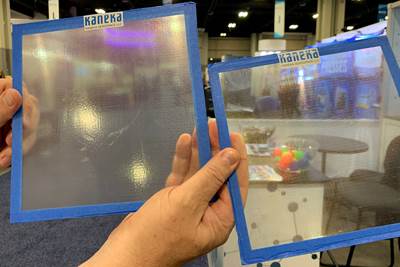Specialty thermoset resins designed for carbon-carbon composites
CAMX 2024: Kaneka Aerospace is demonstrating its novel diamine-based bis-benzoxazine resins, with features such as high char yield, for use as CFRP thermal protection.
Share
Shown here are cured resin films and CFRP after pyrolysis up to 1000°C: (a) Resin film 1, (b) resin film 2 and (c) CFRP. Source | Kaneka North America LLC
Kaneka Aerospace (Benecia, Calif., U.S.) manufactures specialty high-performance prepregs, resins and adhesives for the aerospace and industrial markets. Some of the offerings being presented include Kaneka’s novel diamine-based bis-benzoxazine resins with aldehyde end-terminated groups. Matrix options for high-temperature carbon fiber-reinforced plastics (CFRPs), the resins’ thermal and mechanical properties feature:
- Melt flowability at temperatures below 150°C for processing and converting of uncured resins into fully cross-linked structures by hot press molding at 220°C.
- Cured resins exhibit a high Tg temperature formally well over 230°C with little drop in storage modulus.
- Optimal elongation at break (>4%).
- Weight retention of around 70% for the cured resin when heated in an inert atmosphere to temperatures up to 1000°C
- Resins pyrolyzed up to 1800°C also showed improved residual weight.
Kaneka has also successfully fabricated carbon fiber prepregs with these resins, which were subsequently stacked and cured to yield CFRPs. A presentation in the CAMX theater, titled “Aldehyde Groups Terminated Bis-Benzoxazine Resins With High Char Yield for Carbon-Carbon Composite Applications,” presented by Hideki Yamamoto, highlights some of the preliminary studies on the processing of prepregs using the benzoxazine-based prepregs. Further, details of the post-curing pyrolysis and thermal treatment of the CFRPs are being presented, including a preliminary analysis of the pyrolyzed structure. Notably, the high weight retention of the reported cured resin is said to have translated well even at the CFRP level, which demonstrates optimal weight as well as dimensional retention. These results provide glimpses of the potential of these new materials toward their applications in carbon-carbon composites for the purposes of thermal protection.
Related Content
-
Manufacturing the MFFD thermoplastic composite fuselage
Demonstrator’s upper, lower shells and assembly prove materials and new processes for lighter, cheaper and more sustainable high-rate future aircraft.
-
Infinite Composites: Type V tanks for space, hydrogen, automotive and more
After a decade of proving its linerless, weight-saving composite tanks with NASA and more than 30 aerospace companies, this CryoSphere pioneer is scaling for growth in commercial space and sustainable transportation on Earth.
-
Plant tour: Spirit AeroSystems, Belfast, Northern Ireland, U.K.
Purpose-built facility employs resin transfer infusion (RTI) and assembly technology to manufacture today’s composite A220 wings, and prepares for future new programs and production ramp-ups.
Related Content
Manufacturing the MFFD thermoplastic composite fuselage
Demonstrator’s upper, lower shells and assembly prove materials and new processes for lighter, cheaper and more sustainable high-rate future aircraft.
Read MoreInfinite Composites: Type V tanks for space, hydrogen, automotive and more
After a decade of proving its linerless, weight-saving composite tanks with NASA and more than 30 aerospace companies, this CryoSphere pioneer is scaling for growth in commercial space and sustainable transportation on Earth.
Read MorePlant tour: Spirit AeroSystems, Belfast, Northern Ireland, U.K.
Purpose-built facility employs resin transfer infusion (RTI) and assembly technology to manufacture today’s composite A220 wings, and prepares for future new programs and production ramp-ups.
Read MoreCryo-compressed hydrogen, the best solution for storage and refueling stations?
Cryomotive’s CRYOGAS solution claims the highest storage density, lowest refueling cost and widest operating range without H2 losses while using one-fifth the carbon fiber required in compressed gas tanks.
Read MoreRead Next
AGY, Kaneka develop transparent fiber-reinforced composite
The S-2 Glass fiber/epoxy material offers tunable transparency, low haze, good impact and mechanical properties.
Read MoreKaneka Aerospace starts up carbon and glass fiber prepreg operations
Subsidiary installs new automated filming and prepreg equipment at Benecia, California, facility, with capabilities to produce 50-inch-wide prepreg tapes ranging from 140-1,100 gsm areal weight.
Read MorePlant tour: Daher Shap’in TechCenter and composites production plant, Saint-Aignan-de-Grandlieu, France
Co-located R&D and production advance OOA thermosets, thermoplastics, welding, recycling and digital technologies for faster processing and certification of lighter, more sustainable composites.
Read More









